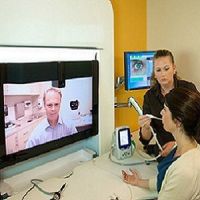Use of telemedicine has expanded to meet the growing spiritual needs of patients, with hospital chaplains now offering spiritual support increasingly through Skype, FaceTime and other high-tech connections, according to an article in the Wall Street Journal.
The demand for spiritual support, in a variety of forms, is expected to increase as hospitals add more palliative-care and hospice programmes, often to patients in their homes. To cope with this trend, some hospitals have called on dedicated service providers. Often, phone or e-mail serves as the telehealth conduit.
For example, the HealthCare Chaplaincy Network, a New York-based nonprofit, just last year launched its “Chat With a Chaplain” service. Thus far, the service has connected chaplains to patients, family members and caregivers nearly 5,000 times.
The service is free to individual callers, but the chaplaincy network is also joining with hospitals to extend their own chaplain services to outpatients, discharged patients, family members and others, for a monthly fee, which can range from $1,000 to tens of thousands of dollars, depending on the hospital’s size and expected volume.
Most academic medical systems and about 70 percent of community hospitals offer some chaplain services, according to the American Hospital Association. However, their costs generally are not covered by Medicare or private insurance, so their resources are often stretched.
“Hospitals may have three chaplains covering 800 beds,” says the Rev. Eric Hall, the network’s president and chief executive. “Many of them would like to offer more services, but there are limitations.”
In the past six months, the network has signed agreements with 26 hospital systems to provide remote access to the networks’ on-call chaplains, facilitate virtual visits with the hospitals’ own chaplains and/or license the organisation’s suite of spiritual TV programming, according to Journal article.
“Most of the ministry that chaplains do is face to face, but there are certainly times when that’s not possible, due to distance or incarceration or a contagious disease, and technology is opening up doors for us,” says Margaret Atkinson, president-elect of the Association of Professional Chaplains.
“Wherever chaplains are, at the bedside or the other end of a video camera, it’s about the human connection,” she says. “That’s what we are there for.”
Source: The Wall Street Journal
Image credit: Flickr.com
The demand for spiritual support, in a variety of forms, is expected to increase as hospitals add more palliative-care and hospice programmes, often to patients in their homes. To cope with this trend, some hospitals have called on dedicated service providers. Often, phone or e-mail serves as the telehealth conduit.
For example, the HealthCare Chaplaincy Network, a New York-based nonprofit, just last year launched its “Chat With a Chaplain” service. Thus far, the service has connected chaplains to patients, family members and caregivers nearly 5,000 times.
The service is free to individual callers, but the chaplaincy network is also joining with hospitals to extend their own chaplain services to outpatients, discharged patients, family members and others, for a monthly fee, which can range from $1,000 to tens of thousands of dollars, depending on the hospital’s size and expected volume.
Most academic medical systems and about 70 percent of community hospitals offer some chaplain services, according to the American Hospital Association. However, their costs generally are not covered by Medicare or private insurance, so their resources are often stretched.
“Hospitals may have three chaplains covering 800 beds,” says the Rev. Eric Hall, the network’s president and chief executive. “Many of them would like to offer more services, but there are limitations.”
In the past six months, the network has signed agreements with 26 hospital systems to provide remote access to the networks’ on-call chaplains, facilitate virtual visits with the hospitals’ own chaplains and/or license the organisation’s suite of spiritual TV programming, according to Journal article.
“Most of the ministry that chaplains do is face to face, but there are certainly times when that’s not possible, due to distance or incarceration or a contagious disease, and technology is opening up doors for us,” says Margaret Atkinson, president-elect of the Association of Professional Chaplains.
“Wherever chaplains are, at the bedside or the other end of a video camera, it’s about the human connection,” she says. “That’s what we are there for.”
Source: The Wall Street Journal
Image credit: Flickr.com
Latest Articles
healthmanagement, telehealth, online communication, Skype, spiritual support, telemedicine
Use of telemedicine has expanded to meet the growing spiritual needs of patients, with hospital chaplains now offering spiritual support increasingly through Skype, FaceTime and other high-tech connections, according to an article in the Wall Street Journ



























